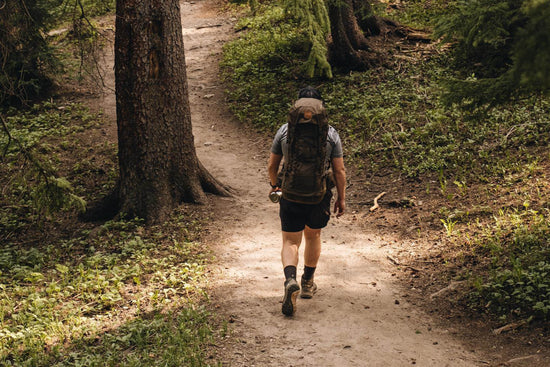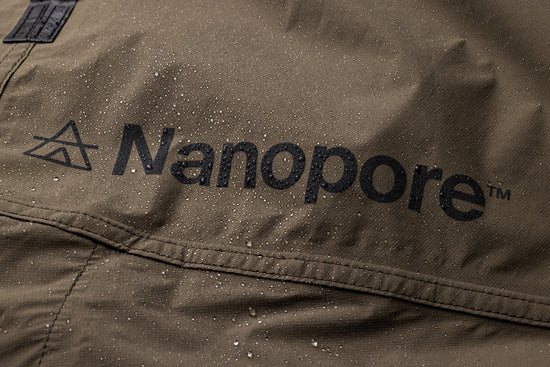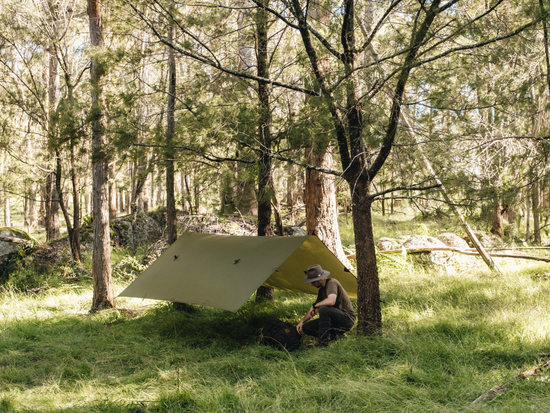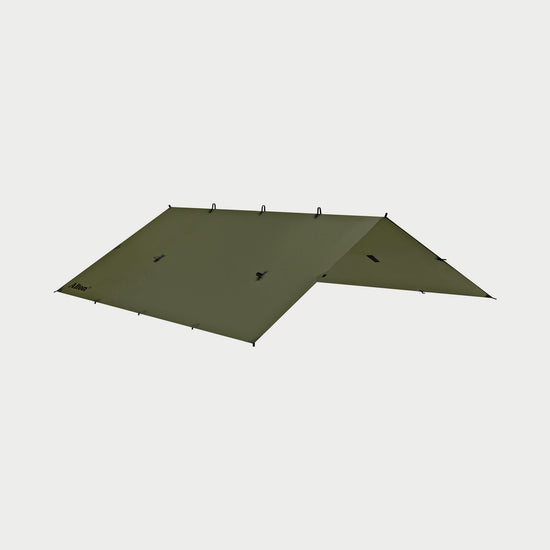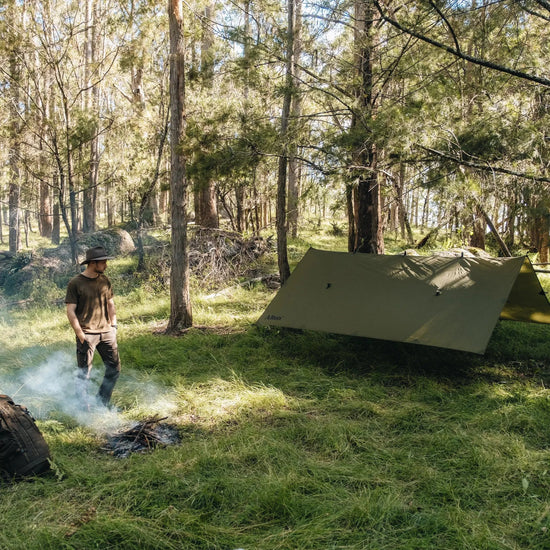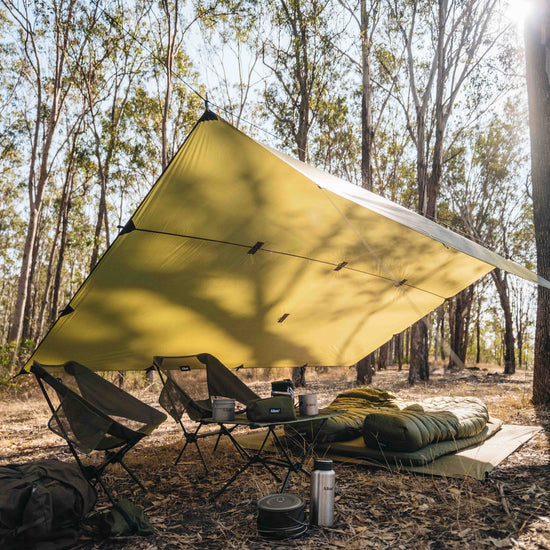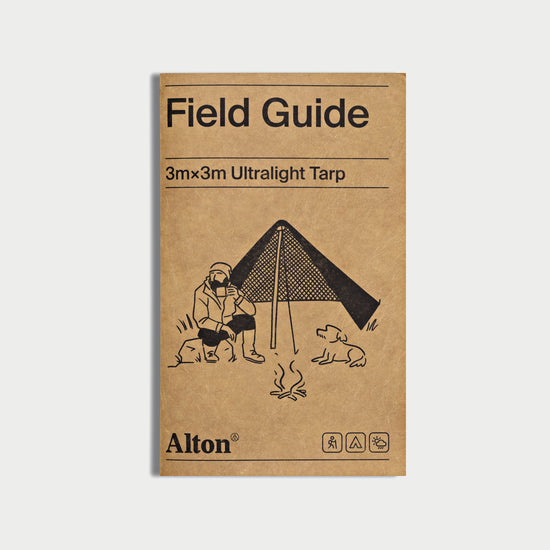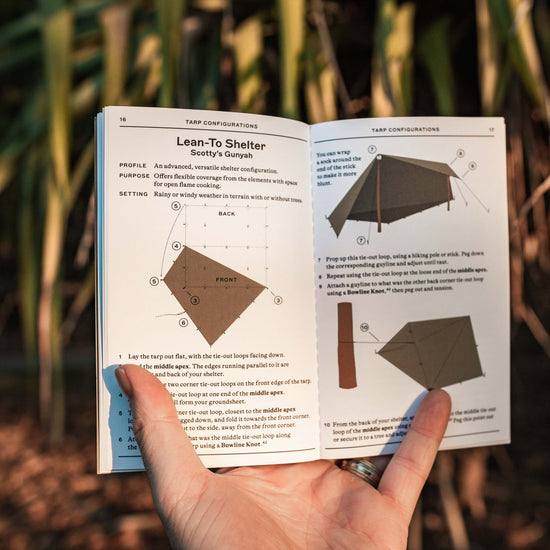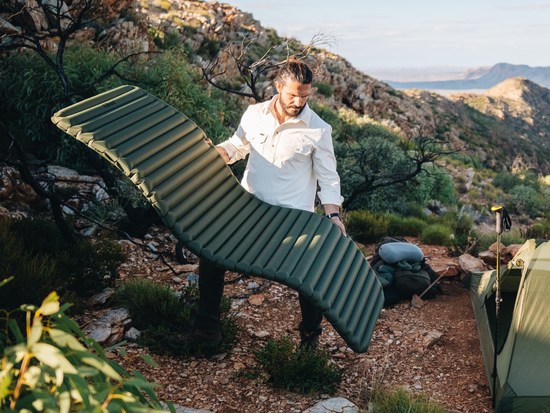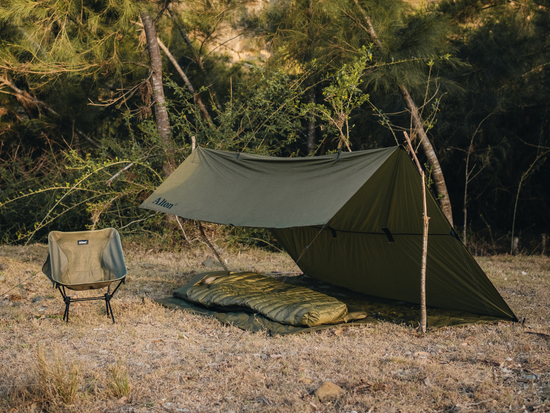Whether you're a seasoned outdoor adventurer or just dipping your toes into the world of lightweight shelters, we've got you covered with this one-stop resource for everything tarp camping.
We've compiled all the information from our blog articles on tarp camping into this essential guide. Think of this as the cliffnotes; you can skim over the key information from all our articles, or dive into the full blog posts for more information.
Alright, enough chit-chat. Let’s get straight to it!

Why should you try tarp camping?
We might be biassed, but we think tarps are great.
They let you embrace the wilderness without constraints. With the limitless configurations of tarp camping, you start to see the environment around you from a new perspective. You build and develop your bushcraft skills, learning how to assess the environment and problem solve to create the ultimate shelter for the conditions.
Here’s why we think everyone should give tarp camping a go:
1. Less weight, more adventure.
There’s a reason why camping tarps are popular among long-distance hikers, bikepackers and bushcrafters; tarp camping really does equip you to go further with less.
2. Master new skills.
The hands-on experience that comes with tarp camping builds valuable outdoor skills, such as weather reading, knot tying and problem solving.
3. Adapt your tarp to any terrain or weather.
With a camping tarp, you can customise your shelter to suit the terrain, weather, and your desired level of protection. From a simple lean-to in mild weather to a fully enclosed A-frame for stormy nights, the possibilities are endless.
4. Budget-friendly and made to last.
Tarps are typically more affordable than tents and, thanks to their minimal design, they are often crafted from highly durable materials that hold up to years of hard use.
5. Be a part of a community.
Once you start tarp camping, you'll find a welcoming group of fellow adventurers online and in person, eager to share tips, tricks, and their favourite configurations.
6. It’s just the best!
Tarp camping allows you to tune into your surroundings, appreciate the simple things, and feel a sense of connection with nature. Try it for yourself and you’ll see – it’s so good!
Head over to our full blog post, 6 Reasons to Try Tarp Camping, to delve deeper into the world of tarp camping. Whether you're a seasoned adventurer or a total beginner, tarp camping has something to offer everyone. So, what are you waiting for? Let’s do this!
Tarp Camping Pros & Cons
Tarp camping offers a lightweight and versatile shelter option for your outdoor adventures. But, before you ditch the tent and embrace the tarp life, it's important to weigh the pros and cons.
Here’s what you need to know:
Camping Tarp Pros
- Lightweight and compact.
- Easy to adapt to different conditions.
- Functions as a shelter, cooking area, sunshade, and more.
- Teaches you valuable outdoor skills.
- Durable enough to withstand harsh conditions.
- Brings you closer to nature.
Camping Tarp Cons
- Can feel less protective from insects and animals
- Offers less shelter than tents in severe weather.
- Not freestanding, so may not be suitable for all campsites.
- Requires time and effort to learn setup techniques and knots.
- Depending on your setup, you might need extra gear
- May not be comfortable in winter conditions.
Ultimately, the decision is yours. If you crave a lightweight, adaptable adventure and don't mind the learning curve, tarp camping can offer you a new way to explore. Read our full blog post, The Pros & Cons of Tarp Camping, for a complete breakdown of the pros and cons of camping tarps.
Camping Tarp vs Tent
It's time to settle the age-old question: tarp or tent? Both options have advantages and disadvantages, so the best choice depends on your needs and preferences. We get into the nitty-gritty to help you decide:
Weight & Packability
Camping tarps take the gold thanks to their lightweight, single sheet design. Tents are generally heavier due to their frame structure and additional components.
Durability
Tarps often have the edge when it comes to durability. Their simple design allows them to be crafted from stronger materials without adding weight.
Weather Protection
Tents have the lead when it comes to weather protection. Their enclosed structure and dedicated rainfly offer superior protection in harsh conditions, keeping you warm and dry.
Insect & Animal Protection
Tents win again. Tarps require additional accessories like bug nets to achieve the same level of security.
Ventilation & Airflow
Tarps reign supreme. Their open design allows for optimal airflow and heat regulation, especially in hot climates.
Condensation Management
It's a draw. Condensation impacts tarps and tents differently depending on the setup and conditions, so there is no clear winner here.
Versatility
Camping tarps are typically more versatile than tents. While tents excel at their primary purpose, they lack the flexibility of a tarp.
Ease of Use
It's a tie. Camping tarps demand more technical knowledge for configuration but can be quicker to set up (once you know how), whereas tents offer a straightforward process with their predefined structure.
Privacy
Tents are better when it comes to privacy. Their enclosed design allows for privacy and a secluded space, where tarps can leave some people feeling uncomfortably exposed.
Value for Money
With lower manufacturing costs and simple designs, tarps are more affordable than tents of similar quality.
So, what’s our final verdict on the tarp vs tent debate? Read the full blog post, Tarp vs Tent: Which is the Best Shelter for You? to find out!

Must-Have Gear for Tarp Camping
Tarp camping offers a minimalist approach to outdoor shelter, giving you ultralight functionality without sacrificing protection. But knowing what gear to bring can be daunting. Here’s a quick refresher of our tarp camping gear list:
Essential Tarp Camping Gear
- Camping Tarp
- Ridgeline
- Guylines
- Prusiks
- Micro Line Locks
- Ultralight Pegs
Optional Tarp Camping Gear
- Supports (eg. hiking poles or sticks)
- Carabiners
- Groundsheet
- Bug Net Tent
- Extra Shelter (eg. swag, bivvy, or tent)
Remember, the required tarp camping gear depends on the conditions you’re facing, your specific needs and personal preferences. Read the full article, Must-Have Gear for Epic Tarp Camping Trips, for a detailed explanation of each item on this tarp camping gear list and expert advice on how to choose the best equipment for your needs.
Knots for Tarp Camping
Tarp camping isn’t rocket science, but it does take some basic outdoor skills to build a secure and stable shelter. Knot tying is one of those essential skills.
We’ve put together a guide to six foundational knots you need to master. Here’s a quick recap of the knots we cover:
1. Bowline Knot
Purpose: Attaching guylines and securing ridgelines.
Advantages: Strong, reliable, easy to tie and untie.
Disadvantages: Can loosen or unravel when unloaded.
2. Adjustable Guyline Hitch
Purpose: Securing and tensioning guylines and ridgelines.
Advantages: Easy to adjust, tie and untie even under load.
Disadvantages: May slide on smooth, wet, or frozen ropes.
3. Siberian Hitch
Purpose: Securing ridgelines or guylines to anchor points.
Advantages: Easy to tie even with gloves, adjustable tension, quick release.
Disadvantages: Not suitable for heavy loads.
4. Prusik Knot
Purpose: Securing a tarp to a ridgeline, creating tension, adjustable attachment point for hanging gear, creating a water-break on your ridgeline.
Advantages: Quick and easy to tie and untie, moveable, highly secure under tension.
Disadvantages: Not effective on wet or frozen ropes, works best on thicker static ropes.
5. Reef Knot
Purpose: Connecting two ends of a rope.
Advantages: Quick and easy to tie and untie, low-profile when tightened, secure for basic outdoor use.
Disadvantages: Comes undone under heavy loads or if jostled around.
6. Trucker's Hitch
Purpose: Securing and tensioning the ridgeline, tensioning guylines.
Advantages: Easy to adjust tension, strong and secure when under tension.
Disadvantages: Falls apart easily when not under tension, can cause wear and tear to ropes over time.
Remember, practice makes perfect. Experiment with these knots outdoors with your tarp shelter to gain confidence and build your skills. For instructions on how to tie each of these tarp camping knots, check out the full article here.
P.s
Our Tarp Camping Field Guide includes step-by-step instructions with visual diagrams for all the essential knots for tarp camping. Pick up your copy today to have it on-hand for your next tarp camping adventure!

The Alton Tarp Size Guide
We have developed three camping tarp sizes here at Alton; the 3 m x 3 m Ultralight Tarp, 3 m x 4 m Ultralight Tarp, and 2.8 m x 1.8 m Ultralight Hoochie Tarp.
Here's a breakdown of each:
3m x 3m Ultralight Tarp
Best for: Solo adventurers or couples, adaptable for various conditions.
Pros: Versatile, symmetrical shape for easy setup, lightweight, spacious for two people.
Cons: Smaller than the other options, may not be ideal for large groups.
3m x 4m Ultralight Tarp
Best for: Group trips or situations where weight isn't a major concern.
Pros: Spacious, excellent coverage for 2-4 people, adaptable, still lightweight compared to tents.
Cons: Slightly heavier than the other options, may require more space for setup.
2.8m x 1.8m Ultralight Hoochie Tarp
Best for: Solo backpackers, bikepackers, and packrafters who prioritise weight and durability.
Pros: Ultra-lightweight, minimalist design, efficient for solo shelter, versatile setup options.
Cons: Smaller coverage area, requires strategic setup, may not be suitable for harsh conditions.
Head over to our size guide article for a detailed look at each of our camping tarps, as well as more recommendations on how to choose the best camping tarp for you.
Tarp Camping Setup Tips & Tricks
This blog is for anyone who wants to take their tarp camping skills to the next level. We share the essential tips and tricks we’ve learned along the way, helping you avoid common mistakes and get the most out of your camping tarp.
Here are our top tarp camping tips in a nutshell:
- Invest in a high-quality, versatile tarp.
- Learn basic knots like Bowline, Prusik & Reef Knot.
- Camp in a sheltered spot with windbreaks.
- Make sure you have access to anchor points – or bring your own!
- Be ready to adapt your shelter configuration to the conditions.
- Use a bug net tent or mosquito net if needed.
- Add a water break to your ridgeline to prevent dripping.
- Pack extra rope and stakes for unexpected situations.
- Do a practice run before your first camping trip.
- Prioritise safety and go in prepared.
For more information on each tip here, along with additional resources and expert advice, be sure to check out the full blog, The Top 10 Camping Tarp Setup Tips for Beginners. With comprehensive information and detailed instructions, it's your guide to crafting your own comfortable and secure tarp shelter, no matter the conditions.
Our Top 5 Camping Tarp Shelter Setups
This guide takes you through five of the most effective tarp shelters for any outdoor scenario. Simple, reliable, and versatile, these setups are some of our all-time favourites for a wide range of weather conditions.
- A-Frame (High Ridgeline)
- Perfect for hot, humid environments.
- Open design promotes airflow and ventilation.
- Easy to set up between two anchor points.
- Lean-To
- Spacious and open-sided, offers great views of your surroundings.
- Ideal for mild conditions with minimal wind.
- Great option for camping with groups.
- A-Frame (Low Ridgeline)
- Ideal for cold or wet conditions.
- Low profile design protects you from the elements and retains warmth.
- Very secure once anchored and tensioned correctly.
- Bivvy Tarp Shelter (Hunchback)
- Highly protective with just enough headroom to move around inside.
- Effective in shedding rain, blocking wind, and conserving warmth.
- Compact and lightweight, ideal for solo camping.
- Tarp Tent
- Enclosed design provides excellent shelter from wind and rain.
- No ridgeline needed, perfect for areas with limited access to anchors.
- Requires hiking poles or sticks for structural support.
- Works best with a 3x3m Ultralight Tarp.
If you are new to tarp camping, these five setups are a great place to start. For detailed instructions and more essential tips, check out the full article here, or grab a copy of our Tarp Camping Field Guide for visual diagrams of each setup.
Don’t Be Fooled By These Tarp Camping Myths!
Think tarp camping is bug infested or wet and miserable, or just experts only? Think again! Here's the truth behind the top 5 tarp camping myths:
Myth 1: Tarps don't stop bugs.
False! Bug nets are your best friends here – use one under your tarp for full protection.
Myth 2: Tarps can't handle bad weather.
False! A good tarp with the right setup can be just as effective as a tent in rain, wind, and even snow.
Myth 3: Animals will invade your tarp.
False! Animals are more interested in food than you. Store your food properly and keep your campsite clean and you’ll be just fine.
Myth 4: Tarps offer no privacy.
It depends. Location matters. In crowded areas, a tarp may not be ideal. But in remote locations, the openness adds to the outdoor experience.
Myth 5: Tarp camping is only for experienced adventurers.
100% False! Anyone can learn. Start with basic knots and simple setups. The more you practise, the easier it becomes.
In our blog, Debunking the Top 5 Myths About Camping Tarps, we make our case for why you shouldn’t let these common tarp camping myths hold you back. Read it today and then get out there to experience the freedom and versatility of tarp camping for yourself!
Happy Tarp Camping!
There you have it – that’s our complete guide to everything you need to know about tarp camping. Of course, there is always more to cover, but we hope this has given you a solid foundation to try tarp camping for yourself.
We’re always adding new topics to our blog, so if you ever have topics you’d like us to discuss, we’d love to hear from you. You can send us an email or DM us on Instagram with any questions you have.

